Targis
Aesthetic complete veneers for metal-free and metal-reinforced restorations
|
A product made from the new Ceromer material Vibrant aesthetics
|
|
Jacket Crowns- Metal Free
|
Veneers- Metal Free
|
Telescope Crowns |
Bridges with Metal Frameworks |
Implant Superstructures with metal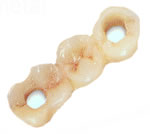 |
Inlays and Overlays- Metal Free |
|
Cementation
|
|
Preparation
The preparation technique is important for the stability of the restoration as well as for the aesthetic result and the accuracy.
# Clear margins are a prerequisite for an accurate restoration. Gingival margins can be prepared with a deep chamfer or a shoulder. Avoid feather edges and long bevels.
# Margins should be sharp, but all internal features, whether positive or negative, should be rounded.
 |
 |
Crowns
- Reduce anatomically. Provide 1.5 mm in fissure areas and the occlusal third of the axial walls. Smooth all transitions.
- In cervical enamel, a flat "bevel" of 10-30" will improve the acid etch pattern.
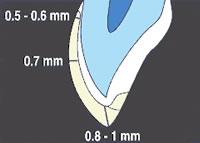 |
Veneers
- The angle of the preparation at the gingival margin is the same as for a crown, and a preparation depth of approximately 0.5 mm is adequate.
- There are many options for the incisal margin. A palatal chamfer is not necessary.
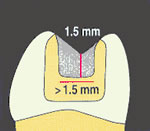 |
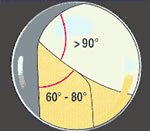 |
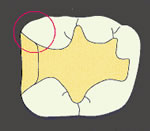 |
Inlays
- Observe antagonist contacts.
- The preparation depth should be approximately 1.5 mm in the fissure area. The same dimension is required for the isthmus.
- The axial walls of the proximal box should be flared slightly. The enamel margin should not form an acute angle.
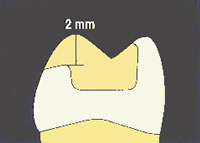 |
Onlays
- Use same procedure as for inlays.
- An onlay with a reduction of 2.0 mm can be prepared horizontally, as shown
Fact 1:Ivoclar in cooperation with several universities has developed advanced polymer systems and ceramic fillers from which high-performance Ceromers (ceramic optimized polymers) have been produced. These Ceromers combine the advantages of ceramics with those of state-of-the-art composites. Ceromers are composed of specially developed and conditioned fine particle ceramic fillers of submicron size (0.04 and 1.0um), which are closely packed (approx. 75-83 weigth percent) and embedded in an advanced temperable organic polymer matrix. |
 |
 |
Fact 2:On the basis of their composition and structure, Ceromers combine the advantages of ceramics, for example, durable aesthetic quality, abrasion resistance, and high stability, with those of state-of-art composites, for example, ease of final adjustment, excellent polishability, effective bond with the luting composite, low degree of brittleness and susceptibility to fracturing, as well as the possibility of repairing restorations in the mouth. In addition to being highly aesthetic, Ceromer restorations also conserve the tooth structure. Furthermore, adhesive cementation with advanced luting composites assures the stability of these restorations. |